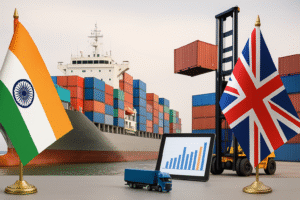
In the realm of international trade, the efficient management of shipment procedures is paramount for seamless transactions and customer satisfaction. For an SME or startup, choosing amongst the various modes of transportation available for export cargo is essential to bring cost effectiveness and optimization in their overall business model. For instance, shipment by sea stands out as the most preferred by SMEs and Startups due to its cost-effectiveness and expansive capacity. However, for startups dealing in high-value items like diamonds and gold, air transportation is often chosen. Understanding the intricacies of the shipment procedure can significantly enhance the efficiency and reliability of global supply chain of an SME or startup. Here is a list of Shipment procedures involved in International Logistics which can help an entrepreneur understand procedures better.
Reservation of Shipping Space/ Booking Confirmation
Upon finalizing the export contract, the exporter initiates the process by reserving the necessary space on a vessel for shipment. This involves issuing a shipping order by the shipping company, detailing the goods to be received on board. The original copy is provided to the exporter, while the duplicate is sent to the commanding officer of the ship.
Internal Transportation Arrangements:
The exporter coordinates the transportation of goods to the designated port, utilizing road or rail networks. Upon loading, the railway authorities issue a Railway Receipt, serving as a title to the goods. The exporter endorses this receipt to facilitate delivery at the port of shipment.
Preparation and Processing of Shipping Documents:
As the goods reach the port, the exporter provides detailed instructions to the C&F agent, along with a comprehensive set of shipping documents. These include the Letter of Credit, Commercial Invoice, Packing List, Certificate of Origin, GR Form, ARE-1 Form, Certificate of Inspection, and Marine Insurance Policy.
Obtaining ‘Carting Order’ in case of LCL :
The C&F agent obtains the ‘Carting Order’ from the Port Trust Authorities, allowing the movement of cargo within the dock area. The cargo is then stored in the appropriate shed as per port regulations.
Customs Clearance:
Before loading, the cargo must undergo customs clearance. The exporter submits the required documents, along with the shipping bill copies, to the Customs Appraiser. After verification, essential documents are returned, and the cargo is cleared for shipment.
Customs Examination and ‘Let Export Order’:
The Customs Examiner physically examines the goods and issues a ‘Let Export Order’ upon satisfaction. Alternatively, this examination can occur at the exporter’s premises with prior approval. The ‘Let Export Order’ is a formal permission for cargo loading.
Obtaining ‘Let Ship Order’:
Supplementing the ‘Let Export Order’ is the ‘Let Ship Order,’ obtained from the Customs Preventive Officer. The C&F agent submits the endorsed shipping bill copy to acquire this order, ensuring compliance with customs regulations.
Obtaining Mate’s Receipt and Bill of Lading:
Upon loading the goods onto the vessel, the Mate or Captain issues a Mate’s Receipt to the Port Superintendent. Upon payment of port dues, the Port Superintendent hands over the Mate’s Receipt to the C&F Agent, who then surrenders it to the Shipping Company for obtaining the Bill of Lading.
(Note- in case of LCL shipment close after realizing DO and Cargo Dispatch or cargo collected by consignor)
Efficiently navigating through each stage of the shipment procedure ensures timely delivery and minimizes disruptions in international logistics operations. By adhering to established protocols and leveraging technological advancements, stakeholders can optimize processes and enhance overall efficiency in the global supply chain.
Documentation and Record Keeping:
Following the completion of the shipment procedure, meticulous documentation and record-keeping are essential for compliance and audit purposes. The exporter maintains copies of all relevant documents, including the Bill of Lading, Commercial Invoice, Packing List, and Certificate of Origin, ensuring transparency and accountability throughout the process.
Tracking and Monitoring:
In today’s digital age, real-time tracking and monitoring systems play a crucial role in ensuring the smooth flow of goods across international borders. Utilizing advanced technologies such as GPS tracking, RFID tags, and blockchain-based platforms, stakeholders can monitor the movement of shipments at every stage, from origin to destination. This not only enhances visibility but also enables proactive decision-making and risk mitigation.
(Note – Tracking Ends After receiving empty containers)
Collaboration and Communication:
Effective collaboration and communication among all parties involved in the shipment process are essential for success. This includes close coordination between exporters, freight forwarders, customs authorities, shipping companies, and port operators. Clear and timely communication helps address any issues or discrepancies promptly, preventing delays and ensuring customer satisfaction.
Continuous Improvement:
The optimization of the shipment procedure is an ongoing process that requires a commitment to continuous improvement. By regularly evaluating performance metrics, identifying areas for enhancement, and implementing best practices, stakeholders can streamline operations, reduce costs, and enhance overall efficiency. Investing in staff training and adopting innovative technologies are key strategies for staying ahead in the competitive landscape of international logistics.
In conclusion, the shipment procedure in international logistics is a multifaceted process that involves careful planning, coordination, and execution. By adhering to established protocols, leveraging technology, and fostering collaboration, stakeholders can navigate through each stage efficiently, ensuring the timely and secure delivery of goods to global markets. Embracing innovation and embracing a culture of continuous improvement are essential for staying competitive and meeting the evolving needs of the dynamic global trade environment. Still feeling overwhelmed and don’t know whom to trust Request a Callback from our Expert !







